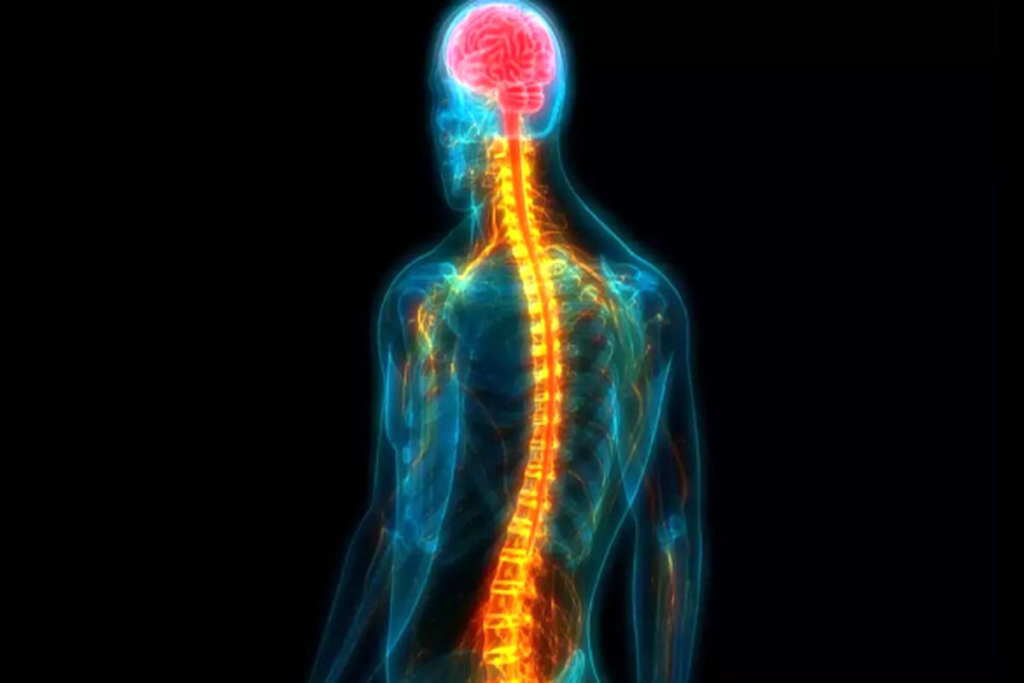We’re here to explain syringomyelia, a rare and often misunderstood condition. It involves a fluid-filled cyst, called a syrinx, in the spinal cord. This can cause the spinal cord to compress, leading to various neurological symptoms.

The syrinx forms due to problems with cerebrospinal fluid (CSF) flow. As we dive deeper, it’s clear that new diagnoses and care methods are making a big difference for patients everywhere.
Syringomyelia is a complex condition where a fluid-filled cavity forms in the spinal cord. This cavity, called a syrinx, can grow and press on the nerve tissue. This can cause many neurological symptoms.
A syrinx forms in the central canal of the spinal cord in syringomyelia. It can happen for many reasons, like Chiari malformation, injury, or tumors. As it grows, it can harm the spinal cord tissue, causing pain, weakness, and loss of sensation.

Syringomyelia is rare, affecting about 8.4 per 100,000 people worldwide. It mainly strikes adults between 20 and 50 years old. Knowing how common it is and who it affects helps doctors diagnose and treat it better.
This condition can cause serious problems if not treated properly. Many cases are linked to Chiari malformation. So, getting a full diagnosis and treatment plan is key.
Knowing what causes syringomyelia is key to managing it. This condition forms a fluid-filled cavity in the spinal cord. It can come from different factors.

Chiari malformation type 1 (CM-1) is closely linked to syringomyelia. Studies show that up to 65% of people with CM-1 get syringomyelia. CM-1 happens when the cerebellar tonsils move down into the spinal canal.
This can block the flow of cerebrospinal fluid (CSF). This blockage can cause a syrinx to form. For more on syringomyelia and Chiari malformation.
Spinal cord injuries can also cause syringomyelia. Spinal cord injury can lead to a syrinx. This happens because of scar tissue and changes in CSF flow.
The chance of getting syringomyelia after a spinal cord injury varies. But it’s a known problem that can really affect a person’s life.
Spinal cord tumors and inflammatory conditions can also cause syringomyelia. Tumours can block CSF flow or damage the spinal cord. This can lead to a syrinx.
Inflammatory conditions like arachnoiditis can cause scarring. This scarring can mess up CSF flow.
Certain spinal abnormalities at birth can lead to syringomyelia. Tethered cord syndrome is one example. These conditions can cause syrinx formation due to mechanical tension or changes in CSF flow.
In conclusion, syringomyelia can come from many causes. These include Chiari malformation type 1, spinal trauma, tumors, inflammatory conditions, and congenital spinal abnormalities. Knowing these causes is important for diagnosing and treating syringomyelia.
It’s important to know the symptoms of syringomyelia early. This condition causes a syrinx in the spinal cord. It affects people in different ways.
Pain is a major symptom of syringomyelia. It can be very painful and last a long time. The pain often feels like burning or aching and can be in the neck, arms, or back.
A unique sign of syringomyelia is “cape-like” sensory loss. This pattern affects the shoulders and upper back. It looks like a cape from old times. Patients may lose feeling in these areas, which helps doctors diagnose the condition.
Many people with syringomyelia can’t feel temperature and pain. This is because the syrinx damages the spinal cord’s pain and temperature pathways. They might not notice injuries, like burns, because they don’t feel pain or temperature extremes.
Progressive motor weakness is another symptom. The syrinx can harm the motor tracts in the spinal cord. This weakness makes it hard to move and balance, affecting daily life. It’s key to watch and manage this symptom to keep patients independent.
Knowing these symptoms helps us diagnose and treat syringomyelia better. This leads to better outcomes for patients.
MRI has changed how we diagnose syringomyelia. It lets doctors find the condition even when patients don’t show symptoms. This new tech has greatly helped us understand and treat syringomyelia better.
Magnetic resonance imaging (MRI) is key for diagnosing syringomyelia. It shows the spinal cord in great detail. This helps doctors spot syrinxes or other issues like tumors. MRI’s accuracy makes it a vital tool in diagnosis.
More MRI scans mean finding syringomyelia in people who don’t show symptoms. This has helped us learn more about the condition. We need to carefully look at these findings to decide what to do next.
When diagnosing syringomyelia, we must think of other spinal cord issues. Symptoms can be similar to those of spinal cord tumours, multiple sclerosis, and other diseases. This careful consideration helps us make the right diagnosis.
For tricky cases or when we’re not sure, we might need more tests. This could include extra MRI scans, electromyography (EMG), or other tests. These help us understand how serious the condition is and what treatment to choose.
Treating syringomyelia needs a detailed plan. This might include surgery, watching the condition, and managing pain. At places like LivHospital, patients get care plans made just for them.
Surgery is key for those with bad symptoms or those getting worse. Surgical decompression techniques help take pressure off the spinal cord. This lets cerebrospinal fluid flow right again. Doctors might do a posterior fossa decompression or syrinx drainage.
Surgery might seem scary, but thanks to new tech, it’s safer now.
For those with no symptoms or mild ones, a watchful waiting approach is used. Regular MRI scans check how the syrinx is doing. This helps decide if more action is needed.
This careful approach is best for those where surgery risks are too high.
Managing pain is a big part of treating syringomyelia. We use medicines, physical therapy, and even acupuncture to help.
Good pain control makes life better and helps with rehab.
Physical therapy is key to keeping patients moving and strong. Personalized exercise plans help manage symptoms and improve function.
We team up with physical therapists to make sure each patient gets the best care.
If syringomyelia is not treated, it can cause severe problems. A growing syrinx can damage nerves in the spinal cord. This can lead to serious issues.
Untreated syringomyelia can cause the spinal cord to deteriorate. As the syrinx grows, it can harm the spinal cord. This can lead to muscle weakness, loss of reflexes, and less sensation.
The syrinx’s growth can also cause permanent nerve damage. Patients may feel constant pain, numbness, or tingling in their limbs. Motor deficits can cause muscle wasting and less mobility, making daily tasks hard.
Untreated syringomyelia can also affect the autonomic nervous system. This can cause bladder problems, bowel incontinence, and low blood pressure when standing. These issues can make the condition worse.
Syringomyelia and its complications can deeply affect a person’s mind. Chronic pain, loss of independence, and mobility issues can lead to depression and anxiety. It’s vital to treat these aspects as part of a full treatment plan.
Some major complications of untreated syringomyelia include:
Knowing these complications shows why early treatment is key. Early action can prevent these issues and improve patient results.
Managing syringomyelia well needs a mix of strategies to help patients live better. It’s tough, but the right methods can make life more comfortable and meaningful.
Pain care is key for syringomyelia patients. We suggest a mix of treatments like medicine, physical therapy, and even acupuncture. Tailoring these to each person can really help with chronic pain.
Good pain management boosts life quality. It lets patients do more and enjoy therapies more.
Adaptive tools can make a big difference for syringomyelia patients. We recommend grabbers, reachers, and dressing aids for daily tasks. Also, making the home safer with handrails and mats can prevent falls.
Temperature sensitivity is common in syringomyelia. It’s important to be careful with hot or cold things. Using gloves or oven mitts and checking water with thermometers can prevent injuries.
Physical therapy is essential for syringomyelia. We suggest exercises that keep muscles flexible and strong. Physical therapists also teach good posture and breathing to support health.
By using these strategies, syringomyelia patients can manage their symptoms better. This improves their life quality of life significantly.
Syringomyelia is a complex condition that needs a deep understanding and effective management. Research is ongoing to better grasp syringomyelia, improve diagnosis, and find new treatments. Improving care is key to better outcomes for those with syringomyelia.
Significant progress has been made in diagnosing syringomyelia, thanks to MRI technology. Research into the genetic and molecular causes of the condition is also advancing. This research is leading to targeted therapies. As we learn more about syringomyelia, we can offer more personalized care and support.
The future of managing syringomyelia depends on continued research and new treatments. By expanding our knowledge and improving care, we can improve the lives of those with syringomyelia. A team effort between researchers, doctors, and patients is vital for making progress and achieving better results.
Syringomyelia is a rare condition where a fluid-filled cyst forms in the spinal cord. This cyst, called a syrinx, can damage the spinal cord over time. Symptoms include pain, loss of sensation, and weakness in muscles.
Several things can cause syringomyelia. These include Chiari malformation type 1, injuries, tumours, inflammation, and birth defects. Knowing the cause helps doctors choose the best treatment.
Symptoms vary but often include pain patterns and loss of sensation. People may also lose feeling in temperature and pain. Muscle weakness gets worse over time, affecting daily life.
Doctors use MRI scans to find the syrinx in the spinal cord. They also look for other signs and do special tests. This helps them understand the condition better.
Treatments include surgery to relieve pressure, watching for symptoms in some cases, managing pain, and physical therapy. The right treatment depends on the patient’s situation.
Subscribe to our e-newsletter to stay informed about the latest innovations in the world of health and exclusive offers!
WhatsApp us